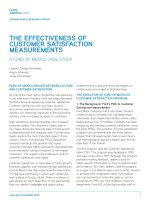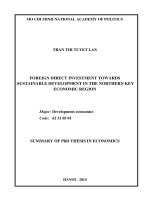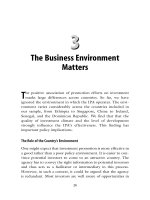world bank the effectiveness of promotion agencies at attracting foreign direct investment phần 5 pot
Bạn đang xem bản rút gọn của tài liệu. Xem và tải ngay bản đầy đủ của tài liệu tại đây (109.53 KB, 13 trang )
The Functions of Investment Promotion Agencies and Their Effectiveness / 37
tively new. For example, Wells and Wint (2001) did not recog-
nize this function in the first edition of their book on promotion
in 1990
29
but they emphasized it in their 2001 revision.
Similarly, many experts have underestimated the role of policy
advocacy when providing advice to IPAs in developing countries
because they did not experience the same urgency in their coun-
try of origin. Irish or Welsh experts, for example, may not
emphasize this function elsewhere because their home countries
have a relatively good investment environment.
The good news is that there is some awareness of the impor-
tance of this function in the countries with a relatively poor
investment climate. Apparently, these countries have tended to
allocate proportionally more financial resources toward this
activity.
30
By allocating resources to the improvement of the cli-
mate for foreign investors, in most cases the agency adds benefits
to local investors. Usually, what is good for foreign investment,
in terms of investment climate, is equally good for the local
investor. Because domestic investors also benefit from the efforts
of the promotion agency to improve the climate for foreign
investment, this can help the agency to deal with criticism that
foreign investors get special attention.
Although the amount of money dedicated to this function may
be small, virtually every agency reported undertaking some form
of policy advocacy. Participation in government-led task forces
seems to be the preferred channel: 80 percent of IPAs surveyed
said they use this method to improve the investment climate. Next,
IPAs count on holding meetings and other interactions with the
private sector to receive feedback on issues in the investment cli-
mate. About 60 percent of the agencies said they undertake
investor perception surveys concerning the domestic investment
climate, and most of them repeat the survey exercise annually.
Who leads the policy advocacy activities? The general manag-
er or senior managers are by far the key people handling these
issues. In about one-third of the countries, members of the
agency’s board or committee get involved, as well.
38 / The Effectiveness of Promotion Agencies
Image Building
Image-building activities absorb about one-fourth on average of
IPAs’ total expenditures. This aspect of marketing a country’s
investment potential involves a range of activities that can be clas-
sified into three main categories: advertising, production of pro-
motional material, and participation in events such as fairs and
conferences.
Participation in public events (seminars, conferences, and so
on) and the production of promotional material consume by far
the most resources. This is particularly the case for developing
countries, which spend 16 percent of total budget on the former
and 14 percent on the latter. Agencies report on average more
than 2,550 information packages distributed to foreign investors
per year over the past three years.
31
Further, the average number
of press releases and briefings is 29 per year.
Agencies tend to spend 10 percent of their total budget on
advertising. This large share is explained by the high cost of
international advertisement. On average, agencies place 9 adver-
tisements in international media per year to promote FDI. In the
case of advertisements in domestic media, however, developing
countries are more active, reporting an annual average of 28
advertisements per year, and industrial countries’ activity in this
area is negligible.
We used the information collected in our survey to test
whether subcategories of image building have different impacts
on the effectiveness of IPAs in (a) advertising in local and inter-
national media, (b) public relation activities (fairs, presentations),
and (c) production and distribution of promotional material.
The only significant difference that appears for the image-
building function is in spending on advertising, which does not
seem to have a significant association with FDI. In contrast,
expenditures on promotional material and public relations activ-
ities do matter significantly (their elasticity coefficients are close
to 0.4). This finding supports the argument that IPAs generally
The Functions of Investment Promotion Agencies and Their Effectiveness / 39
should not engage in aggressive and expensive advertising cam-
paigns but rather concentrate on the production and distribu-
tion of promotion materials as well as public relations activities,
especially if the agency follows up the initial contacts. Not sur-
prisingly, networking is viewed as one of the essential qualities
for an IPA.
Investor Services
The core of many investment promotion efforts is the provision
of services to investors. This function appears quite high on the
IPA’s agenda, at least in terms of budget allocation. It seems to
be effective because in doing so the agency takes care of investors
who made the initial effort to visit the country, but it can also
motivate existing investors to reinvest their earnings into the
country.
According to IPAs’ budgets, there are several main activities
related to investor services:
■ Preinvestment activities absorb about 15 percent of an
IPA’s budget. Agencies reported that on average they
provide basic information to about 290 potential
investors per year (box 4.2). Of this figure, they provide
assistance-arranging missions for roughly one-third.
■ Assisting investors during project implementation
32
(for
example, assistance with business or tax registration, sec-
toral licensing, land, construction, and utilities) is usually
offered by agencies that act as “one-stop shops.”
Accordingly, IPAs in industrial countries spend about 14
percent of their total budget on these services, but devel-
oping ones spend only 7 percent.
■ Seventy percent of agencies report having developed
postinvestment services, including periodic meetings
with existing investors in an effort to gather information
on issues they face and help them resolve problems.
40 / The Effectiveness of Promotion Agencies
These three kinds of assistance to investors appear to be equal-
ly associated with foreign investment (the estimated elasticity is
around 0.2 for all these categories).
When they assist investors, about 40 percent of the promotion
agencies report being involved in the foreign investor’s register-
ing or licensing process, with about 20 percent of these agencies
having the direct power to approve investments. Moreover, more
than 40 percent of IPAs report being in charge of granting some
sort of fiscal or other incentives to investors, but only 14 percent
said their agency had final decisionmaking power in granting
them. Similarly, half of the agencies said they act as a one-stop
shop for foreign investors, with an even higher proportion (80
percent) in developing countries. Yet these additional institu-
tional powers do not seem to increase the effectiveness of the
promotion agencies because we did not find any significant rela-
tionship between them and FDI inflows. As detailed in box 4.3,
only a few agencies have been able to operate as successful one-
stop shops.
Investment Generation
Investment generation appears to be weakly associated with
cross-country variations in FDI flows. Most practitioners would
Box 4.2 Preinvestment Activities
A typical IPA assisted about 90 potential foreign investors to arrange
their visit to the host country. It arranged airport pickups for roughly
76 percent of those investors and would have organized meetings
with government officials for about the same amount.
The average IPA organized a wrap-up meeting at the end of the
mission with nearly 60 percent of foreign investors and would have
followed up with 73 percent of investors after their visit.
The Functions of Investment Promotion Agencies and Their Effectiveness / 41
agree that investment generation has the lowest return, and,
especially in our sample, that includes a majority of countries
with relatively poor investment climates. This finding might be
explained by the high cost and high degree of expertise required
Box 4.3 One-Stop Shops
Recognizing that administrative practices pose a threat to their poli-
cy reform efforts, governments often try to find practical ways to cre-
ate a more attractive business environment. An IPA, being the point
of first contact and gate of entry for many investors, seems to be the
most appropriate candidate to tackle these issues. During the 1980s,
the concept of a one-stop shop (OSS) came into fashion as a vehicle
to deal with administrative barriers and so improve the investor poli-
cy environment.
The concept of an OSS is very appealing. The basic idea is that an
investor would only have to be in contact with a single entity to
obtain all the necessary paperwork in one streamlined and coordi-
nated process. The most outstanding and well-known examples
include the Economic Development Board of Singapore, the
Malaysian Industrial Development Authority, and the Industrial
Development Authority of Ireland.
Yet these successful OSSs are exceptions rather than the rule
around the world. Practically all governments that have tried to
implement OSSs have encountered considerable resistance by the
various government agencies responsible for the administrative pro-
cedures. Most important, other ministries and agencies fear that the
creation of such an OSS would result in curtailing their authority and
mandate. Thus, they quickly lead to intensive turf battles within the
government bureaucracy. Without the necessary political support,
OSSs have proved to be more a “one more stop” because investors
have to interact with one more entity in the process of implementing
their projects.
(For a fuller discussion, see: Sader, F. 2003. “Do One-Stop Shops
Work?” FIAS,Washington, D.C. Processed.)
42 / The Effectiveness of Promotion Agencies
to effectively carry out targeted programs. An agency needs spe-
cialists, by sectors or enterprises, and usually time and attention
to convince a particular investor to locate in its country. It takes
time and money to contact investors proactively and convince
them to invest in the country. Therefore, it is not really surpris-
ing that investment generation activities account for an impor-
tant part of agencies’ expenditure because it is a relatively costly
activity.
The agencies surveyed have developed targeted programs with
the following general features:
■ Sixty-three percent of them report using programs tar-
geting specific countries.
■ Close to 55 percent target specific firms and sectors.
■ About 50 percent have developed programs focusing on
expansion from existing investors.
■ Forty-five percent promote joint-venture activities with
domestic investment partners.
Once IPAs have targeted their specific audience, which can
combine some of the approaches described above, they use a
variety of instruments to contact and eventually convince poten-
tial investors to become actual investors. Our findings show that
of all the promotional activities, the largest percentage of budg-
et (nearly 20 percent) goes toward contacting investors—face-to-
face; by phone, mail, and telemarketing; and conducting mis-
sions abroad. In addition, many IPAs organize meetings for
investors with potential local partners or actively conduct sectoral
or market studies for specific groups of investors. This activity
appears less important than proactive contacts, but it still
accounts for a significant fraction of the IPAs’ budget, almost 16
percent of their total resources.
A rough “back-of-the-envelope” calculation suggests that the
average developing country spent approximately US$133 per
investor contacted through this method, and the average indus-
The Functions of Investment Promotion Agencies and Their Effectiveness / 43
trial country spent about US$482.
33
These levels of expenditures
are not explained by different ways to contact investors (the pro-
portions of face-to-face contacts are approximately the same
between developing and industrial countries) but rather by the
overall level of budget associated with each agency. The IPAs in
industrial countries spend more per investor contacted simply
because they have higher budgets than those in the developing
world. In spite of these differences in the expenditure levels, it is
worth recalling that we have not been able to depict significant
variations in the effectiveness of investment generation across
agencies.
Table 4.2 Average Number of Investors Contacted per Year by Agency
Total Of which Of which
proactive Of which by by mail or Targeted
contacts face-to-face telephone telemarketing missions
All countries 1,872 382 374 959 12
Developing
countries 1,395 309 256 667 11
Industrial
countries 3,955 750 904 2,289 17
Source: FIAS survey (2002).
44 / The Effectiveness of Promotion Agencies
Technical Appendix
We test how IPA effectiveness can be influenced not only by the
amount of resources spent by the agency but also by how these
resources are allocated across its functions or activities. To
explore this question, the promotion effort is divided into its
four components (image building, investment generation,
investor services, and policy advocacy), and their impact on FDI
flows is assessed. In other words, we disaggregate the promotion
effort to obtain the following equation:
FDI
i
= b
0
+ b
11
IB
i
+ b
12
IG
i
+ b
13
IS
i
+ b
14
PA
i
+ b
2
EV
i
+ b
3
IPAC
i
where IB is defined as the effort in image building, IG as invest-
ment generation, IS as investor services, and PA as policy advocacy.
To test this question, we use the same methods described in
the technical appendix of chapter 2. The elasticity coefficients
associated with each function are summarized in table 4.1 of the
main text.
45
5
5
Key Internal Characteristics of
Investment Promotion
Agencies and Their Roles
T
he conceptual framework developed by Wells and Wint (1990,
revised 2001) suggests that an IPA’s effectiveness is influenced
by its institutional structure and reporting mechanisms. Our
empirical findings suggest that structure matters. The most effi-
cient agencies share a high political visibility and relatively strong
private sector participation. These influences are generally mag-
nified through the existence of a board of directors, which
includes representatives from the private sector and is chaired by
the country’s prime minister or president. Other IPA character-
istics—such as their legal status, mandate, or sources of fund-
ing—were not identified as being important.
Main IPA Characteristics
Most advisers to IPAs argue that an agency’s legal status, degree
of private sector participation, or mandate influence the way the
IPA does business and its ability to attract foreign investors.
46 / The Effectiveness of Promotion Agencies
We examined the main IPA characteristics suggested by Wells
and Wint (2001). In particular, the survey conducted by FIAS
identified a set of internal variables that capture the institutional
structure of each agency:
■ Age of the agency
■ Legal status of IPAs (founded by law or decree)
■ Institutional affiliation and linkages with government
(public, semipublic, autonomous, or private body)
■ Linkages with the private sector (financial contribution,
frequency of meetings and inputs, degree of private sec-
tor representation on board)
■ Reporting arrangements (board, government body,
prime minister or president)
■ Overseas offices
■ Number of mandates on top of foreign investment pro-
motion (for example, export promotion, privatization
programs)
■ Staff’s characteristics and salary policy (civil servant, wage
level compared with the private sector, bonuses and
incentives).
Many IPAs share similar characteristics (see box 5.1). Most
agencies are relatively young: only 25 percent of IPAs reported
that they are older than 10 years and only 12 percent are more
than 20 years old. Similarly, almost all IPAs were created either
by law or decree. Another common feature is that almost 80 per-
cent of the IPAs report that they are public institutions: they are
sometimes integrated within a ministry or established as an
autonomous agency, which provides them with an independent
budget. Only 25 percent of IPAs from the developing world have
overseas offices (versus 80 percent in high-income countries).
The few IPAs in developing countries that have a presence
abroad said they use embassy channels to promote investment
instead of establishing their own offices abroad.
Key Internal Characteristics of Investment Promotion Agencies and Their Roles / 47
We also observe little variation in the qualifications of IPAs’
staff and their wage policies. Most report that nearly 80 percent
of the employees have reached university or highest level of tech-
nical education, and almost 60 percent have had previous private
sector experience. The majority of IPAs indicate that they offer
bonuses and other performance-based incentives to their staff.
Offering such incentives undoubtedly attracts qualified people
and motivates them. This uniformity appears relatively surprising
because of the public sector status of the majority of agencies.
We find more variations in the reporting mechanisms across
agencies. IPAs report to a minister, a board of directors—often
composed of both private and public representatives—or both.
The level of political visibility varies considerably across agencies,
but only 10 percent of IPAs surveyed report to a prime minister
or president. Almost two-thirds of the IPAs surveyed report to a
board of directors, which is usually responsible for supervising
the agency’s performance and defining its global strategy. In
most instances, some variation of arrangement for reporting to a
ministry exists in parallel. Most boards include representatives
from both the private and public sectors, generally in equal num-
bers. Public sector participation ensures links with the govern-
ment, which remains predominant in terms of strategy and fund-
Box 5.1 Snapshot of a Typical IPA in a Developing Country
The typical IPA in a developing country is relatively young, created
less than 10 years ago either by a decree or law and constituted as a
public body, as part of a ministry, or as an autonomous agency. It
reports to a minister or a board of directors or sometimes to both.
Most often, its mandate goes beyond the promotion of foreign
investment and includes domestic investment and export promo-
tion. Still, the IPA tends not to have the prime responsibility for priva-
tization or for promotion of such key sectors of the economy as min-
ing, agriculture, and special economic or industrial zones
48 / The Effectiveness of Promotion Agencies
ing. However, participation of the private sector can help
increase the agency’s visibility and credibility. Strong private sec-
tor linkages can enhance policy dialogue on investment issues
and overall governance, management, and performance of the
agency. In addition, it also raises the perception of objectivity by
potential investors, who tend to be fearful of biased sources of
information through purely governmental agencies.
The last characteristic we examined is the number of mandates
assigned to the IPAs. Agencies generally have a mandate that
goes beyond foreign investment promotion. Often, they com-
bine domestic investment promotion (54 percent of IPAs),
export promotion (34 percent), or privatization (19 percent) or
all three. The number of mandates assigned to IPAs appears to
be inversely correlated with the income level of the country in
which the agency has to operate, suggesting that agencies tend
to combine their responsibilities when they face tight constraints
on budgets or human resources.
Figure 5.1 Correlation between Number of Mandates and GDP per
Capita
0
1
2
3
4
5
6
7
8
9
0 5,000 10,000 15,000 20,000 25,000 30,000
Income per capita
Number of mandates
Key Internal Characteristics of Investment Promotion Agencies and Their Roles / 49
Which Characteristics Really Matter?
We expect that the characteristics described above may influence
the effectiveness of IPAs in attracting FDI flows through two
channels. First, they can affect them independently of the level of
promotion effort. For example, an agency might be consistently
more effective if it receives strong political support through
direct reporting links to the highest government authority in the
country. Second, we explore whether these characteristics are
related to the degree of promotion effort carried out by the
agency. It is possible that IPA effectiveness is enhanced when the
agency benefits from strong political support in high places or
the adoption of a focused mandate.
Although we tested all the above characteristics with alterna-
tive specifications, using both dummy variables and interactive
terms associated with the IPA budget variable, only three char-
acteristics seem to have significant effects on the effectiveness of
IPAs across countries (see technical appendix for detailed
results):
■ FDI flows are significantly lower in countries where the
IPA is part of a ministry instead of an autonomous body
or a joint private-public institution.
■ The effectiveness of IPAs is enhanced when the agency
reports to a supervisory board that includes representa-
tives of the private sector. The higher the number of pri-
vate members, the greater IPA effectiveness.
34
■ When the agency reports directly to a country’s president
or a prime minister and all other factors are equal, it is
found to be associated with higher FDI flows.
35
These findings suggest that the most effective IPAs benefit
from visibility and from participation by the private sector
through their boards or through institutional relations. These
characteristics reinforce the leverage of the agency and its role.









